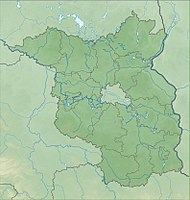Rough Luch
|
Rough Luch
|
||
|
Rough Luch |
||
| location | Brandenburg , Germany | |
| surface | 42.01 hectares | |
| WDPA ID | 165112 | |
| Geographical location | 52 ° 9 ' N , 13 ° 10' E | |
|
|
||
| Setup date | May 29, 1937 | |
The Rough Luch is a 42.01 hectare large nature reserve on the municipal area of the municipality Nuthe glacial valley in the district of Teltow-Fläming in the state of Brandenburg .
location
The nature reserve is located south of the Märtensmühle district . To the west is the district of Berkenbrück , to the south the district of Ruhlsdorf and to the east the district of Liebätz (all to Nuthe-Urstromtal). To the south are the natural monuments of Porathenluch and Blankes Luch, which together with the Rauhen Luch and the surrounding forest form three contiguous bog areas totaling 111.7 hectares. They belong to the Luckenwalder Heide, which in turn belongs to the large landscape of Central Brandenburg plateaus and lowlands .
history
The Rauhe Luch was formed in the last Vistula Ice Age , when the ice of the receding glacier melted and formed depressions. Groundwater and precipitation created permanently moist areas, which in this case took the form of an intermediate moor. This resulted in ground moraine areas with isolated terminal moraine heights. The result was a landscape with a mean height of 42 m above sea level , which slopes slightly towards Nuthe .
In the 19th century, craftsmen dug drainage ditches towards the Nuthe. From then on, peat was cultivated intensively in the area; numerous peat cuttings were made . The Nuthe-Nieplitz Nature Park indicates in a flyer that the area, which is difficult to access, is said to have "served as a hiding place for the villagers" in an earlier time. The area was placed under protection with effect from May 29, 1937. In 2002 it was upgraded to an FFH area .
In the 21st century, around 80% of the area is owned by the State of Brandenburg. 10% belong to private owners, while the remaining area belongs to Bodenverwertungs- und -verwaltungs GmbH, the municipality of Nuthe-Urstromtal and the Brandenburg Nature Conservation Fund.
Flora and fauna
The plants in the bog thrive on peat substrates as well as medium and coarse sands, which are supplemented by clay . Bog birch and bog birch trees also grow there . The small water hose , the white water lily , the dwarf hedgehog and the onion rush grow in the water-filled peat cuttings . The banks are usually overgrown with pipegrasses , flutter rush , bank wolfstrapp , swamp hairline , stiff sedge and the common loosestrife . Peat moss , mean sundew , round-leaved sundew, common cranberries and narrow-leaved cotton grass continue to thrive in the area . In the southern area an old stock of oaks grow on an island-shaped elevation .
The lynx is populated by 30 breeding species of birds. The crane and common snipe live there . In addition to the Blanken Luch, the Rauhe Luch in particular is one of the last places of refuge for numerous species of butterflies in Brandenburg, including the Blue Moor , the Large Meadow Bird , the Spiegelkopf Dickkopf and the Brown Spotted Mother-of-Pearl . In 2006 35 species of butterflies were found. Up to 11 species of dragonflies live in the peat cuttings, including endangered species such as the northern moss damsel and the southern rush damsel .
development
The groundwater level has fallen sharply in the past few decades. This allowed the pipe grass to expand due to silting processes, while the areas rich in peat moss were pushed back. Experts try to stabilize the water balance by rewetting and removing trees. The drainage system is to be dismantled and the formation of new groundwater promoted. The measures are to be supported by decussing . The Teltow-Fläming district has set up an expert group for this purpose. The long-term plan is to enrich the pine forests with oak forests and to expand the old wood stock. Work started in the 2010s. The state forest ranger's office in Belzig assumes that the moor can grow by one millimeter per year. The original state before the human intervention could therefore be restored in around 2000 years.
Individual evidence
- ↑ Nuthe-Nieplitz Nature Park (ed.): Rauhes Luch Nature Reserve , Flyer, no date, p. 6.
- ↑ Hartmut F. Reck: Lots of moss for Moor . In: Märkische Allgemeine , May 30, 2016, accessed on November 20, 2018.
literature
- State Office for Environment, Health and Consumer Protection (Ed.): Management plan Natura 2000 in the state of Brandenburg, Management plan for the Rauhes Luch area , November 2014, p. 37.
- Nuthe-Nieplitz Nature Park (publisher): Rauhes Luch nature reserve , flyer, no date, p. 6.
Web links
- Ordinance on the Jägersberg-Schirknitzberg nature reserve , website of the State of Brandenburg, accessed on October 12, 2018
- World Database on Protected Areas - Rauhes Luch (English)


